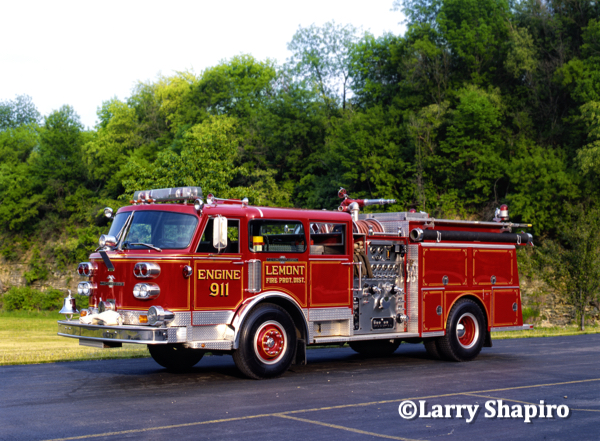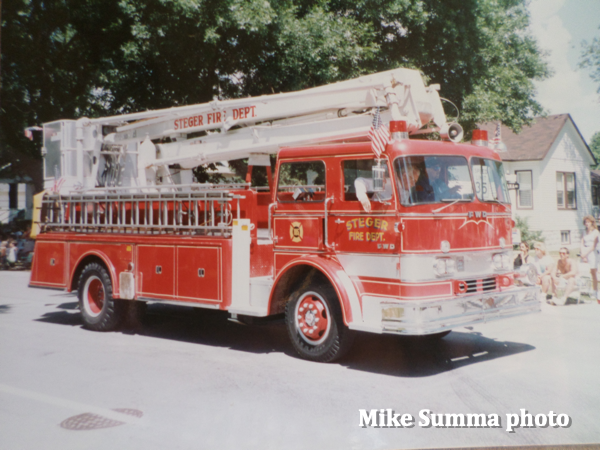This from Larry Shapiro for #TBT

1982 American LaFrance Century Series engine with 500 gallons of water and a 1,500-GPM pump. Larry Shapiro photo

1983 American LaFrance Century Series 75? Water Chief Quint (1500/500). Larry Shapiro photo
Jan 25
Posted by Admin in Fire Department History, Fire Truck photos, Historic fire apparatus, throwbackthursday | 12 Comments
This from Larry Shapiro for #TBT

1982 American LaFrance Century Series engine with 500 gallons of water and a 1,500-GPM pump. Larry Shapiro photo

1983 American LaFrance Century Series 75? Water Chief Quint (1500/500). Larry Shapiro photo
Tags: #larryshapiro, #TBT, American LaFrance Century engine, American LaFrance Water Chief Quint, chicagoareafire.com, classic fire truck photos, Larry Shapiro, larryshapiro.tumblr.com, Lemont Fire Protection District, Lemont Fire Protection District history, shapirophotography.net, throw back thursday, throwbackthursday, vintage fire truck photos
Excerpts from bbc.com:
Much of the US relies heavily on non-career firefighters, but their ranks are dwindling. If the problem doesn’t abate, there’s a lot at stake.
During Covid-19, I – like many others – found myself wondering what I could do to help. After passing by a local fire station many times, I checked out the department’s website and found that they needed volunteers.
I knew volunteer fire departments existed, but I didn’t think my town, an 8,500-person suburb of New York City – Hastings-on-Hudson, 20 miles (32km) from Midtown Manhattan – had one. I was also surprised to learn that even in the largest metropolitan area in the US, a large percentage of the population doesn’t have full-time fire departments.
Instead, volunteer firefighters do the work that paid, professional – “career” – firefighters do. They are essential to their US communities. Yet many of these volunteer departments, especially across rural and suburban areas, are struggling.
They often have a shortage of people willing to do the job. Even when new recruits join, many simply can’t commit to being on-call or at a firehouse as they juggle careers and family dynamics. And those who do stay are often older men who are close to aging out; at 38, I am one of the younger members at my firehouse.
Of the more than one-million firefighters in the US, 65% of them are volunteers, according to data from the National Volunteer Fire Council (NVFC). Of the more than 29,000 fire departments across the country, almost 19,000 of them are run completely by volunteers.
Internationally, that’s not entirely unusual. In many European countries, the fire service is composed mostly of volunteers – a list that includes Austria, Germany and Portugal. Australia also relies heavily on volunteer firefighters, as do parts of the UK. But the US’s reliance is particularly significant, due to the country’s larger geographic footprint and population.
About 85% of the US population is covered by career departments, which means most households live in areas serviced by full-time fire departments. Yet that still leaves 15% of the country in the hands of volunteers.
In Kansas, volunteers probably protect 85% of the state, which is similar to other largely rural states. In Iowa, the figure is 92%. In Minnesota, paid-on-call or volunteer firefighters comprise 97.5% of the state’s firefighting force.
These are the areas most likely to struggle to find volunteers, as there’s a smaller population to draw from; and some volunteers, especially younger ones, may move away.
The number of volunteer firefighters in the US numbered nearly 898,000 in 1984, but only around 677,000 in 2020, according to the NVFC data. During that time, the number of calls to those departments has more than tripled, from less than 12 million nationwide in 1986, to more than 36.6 million in 2021.
The severity of the issue varies from city to city and state to state. In New York, it is glaring. Since the late 1990s, there has been a 32% decrease in the amount of volunteering while the amount of calls has gone up 29%.
Several factors are in the affect volunteers including the state of the economy where you need to have one or two jobs and childcare to be able to volunteer. In years past, many volunteers – often men – were able to come home from their jobs, put in the hours and go on calls on evenings and weekends while depending on their spouses for care. Even today, only 11% of volunteer firefighters and 5% of career firefighters in the US are women.
By definition, firefighting is also dangerous – a problem that’s always looming. There are health effects to consider – both mental and physical. It can be emotionally draining, too, especially for volunteers who end up on particularly grisly calls and have trouble processing what they’ve seen. Firefighters exposed to various hazardous substances also increase their risks of developing cancer or other diseases, which is a concern for potential recruits.
The USFA has been identifying ways to help volunteer departments fill their classes and keep those recruits. In 2022 and 2023, the USFA held summits, bringing together numerous leaders in the fire service to try and “get a sense of the scope and the scale”.
Potential solutions, some of which are included in the USFA’s recently published recruitment and retention manual, include apprenticeship programs for the fire service, which could help young people see it as a viable career path. Mentorship programs are another retention strategy, as is family support.
The US federal government also offers financial incentives in the form of grants to many departments, many are available through Fema, including Staffing for Adequate Fire and Emergency Response (Safer) grants.
One way to fix the staffing situation would be to replace volunteer departments with career departments. However, the financial burden would likely fall on community members with tax increases.
thanks Martin
Tags: chicagoareafire.com, National Volunteer Fire Council (NVFC), recruiting for volunteer fire departments
Jan 25
Posted by Admin in Fire Department History, Fire Truck photos, Historic fire apparatus, throwbackthursday | 2 Comments
This from Mike Summa for #TBT:
For TBT-This was the Steger Fire Dept.’s #105, a 1960 FWD 0/0/50′. Enjoy and comment.Mike Summa

Mike Summa photo
Tags: #TBT, chicagoareafire.com, Mike Summa, Steger Fire Department history, throw back thursday, throwbackthursday, vintage FWD fire truck, vintage Snorkel
You are currently browsing the archives for Thursday, January 25th, 2024

For the finest department portraits and composites contact Tim Olk or Larry Shapiro.
Arclite theme by digitalnature | powered by WordPress